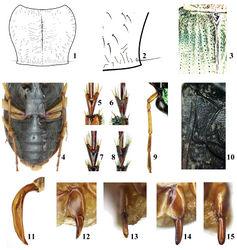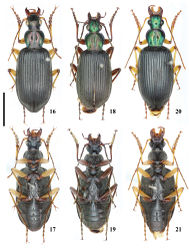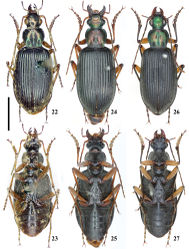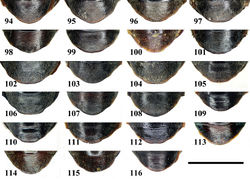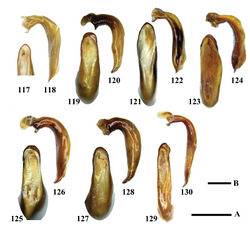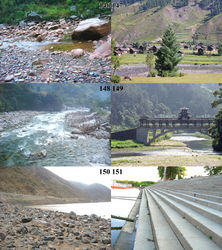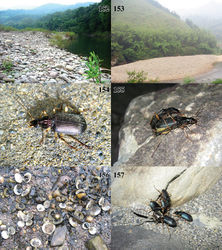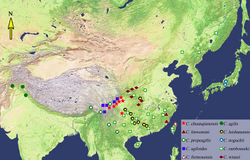Lithochlaenius
| Notice: | This page is derived from the original publication listed below, whose author(s) should always be credited. Further contributors may edit and improve the content of this page and, consequently, need to be credited as well (see page history). Any assessment of factual correctness requires a careful review of the original article as well as of subsequent contributions.
If you are uncertain whether your planned contribution is correct or not, we suggest that you use the associated discussion page instead of editing the page directly. This page should be cited as follows (rationale):
Citation formats to copy and paste
BibTeX: @article{Liu2011ZooKeys128, RIS/ Endnote: TY - JOUR Wikipedia/ Citizendium: <ref name="Liu2011ZooKeys128">{{Citation See also the citation download page at the journal. |
Ordo: Coleoptera
Familia: Carabidae
Name
Kryzhanovskij, 1976 – Wikispecies link – Pensoft Profile
- Hemichlaenius Lutshnik, 1933:169 (nec Bates, 1892:307). Type species Chlaenius rambouseki Lutshnik, 1933; Kryzhanovskij, 1976:11
- Lithochlaenius Kryzhanovskij, 1976:9. Type species Chlaenius rambouseki Lutshnik, 1933; Morita, 1993:161
- Agilochlaenius Kirschenhofer, 1997:116. Type species Chlaenius latro LaFerté–Sénectère, 1851; Kirschenhofer, 2000:58
Diagnosis
Antennomere 3 distinctly longer than antennomeres 1 and 2 combined (Fig. 9); pronotum distinctly cordate (Fig. 1), disk glabrous or sparsely pubescent, each hind angle with single seta (Fig. 2); scutellar setiferous pore puncture present (Fig. 3); venter densely pubescent laterally, sparsely pubescent or glabrous medially (Fig. 4); prosternal intercoxal process punctate, bordered at apex; metepisterna long and narrow (Fig. 10); basal margination of elytra incomplete, absent from medial portion; anterior tarsomere 4 short and deeply emarginate apically (more distinctly so in male, Figs 5–8); aedeagus tubular, ejaculatory orifice long, extended to basal fifth of aedeagus, lamella short (Figs 11, 117–145); gonostylus of female ovipositor smooth, with one setiferous pore near apex and one slender spine at basal inner margin (Figs 12–15).
Description
Length 12.0–18.0 mm, width 4.6–6.4 mm. Head and pronotum black, with green, blue or coppery metallic luster; elytra black, with blue or coppery luster in a few species; ventral surface black; legs black, brown or yellow; antennae yellow, brown, or dark brown.
Head with vertex nearly glabrous, or sparsely and coarsely punctate behind posterior level of eye; eyes moderately prominent; genae pubescent; antennae long, antennomere 1 (scape) coniform (Figs 52–53, 57–59), cylindrical (Figs 56, 60), or elongate-ovoid (Figs 54–55, 61–65); antennomere 3 sparsely setose, distinctly longer than antennomeres 1 and 2 combined (Fig. 9); mandibles triangular, hooked at apex; labrum with six setigerous punctures near apex; maxillary and labial palpi cylindrical, slightly compressed at apex; maxillary palpi glabrous; penultimate labial palpomere with a few setae, apical labial palpomere glabrous; glossal sclerite with two subapical setae; tooth of mentum bifid or emarginate at apex, with one pair of setae near the base; gula glabrous, slightly rugose.
Pronotum cordate (Fig. 1), widest at apical one-third, front angles obtuse, hind angles acute; lateral margins bordered; disk glabrous or sparsely pubescent, base longitudinally rugose, punctate; basal foveae small, deep, rugose, pubescent; hind angles each with one seta (Fig. 2).
Elytra moderately convex, oblong, with distinct isodiametric microsculpture at least laterally; scutellar striae long, with basal setiferous pore present (Fig. 3); at least outer intervals pubescent (Figs 80–93), pubescence on intervals 8 and 9 generally denser than on others; wings full-sized, functional.
Abdominal sterna densely pubescent laterally, sparsely pubescent or glabrous medially (Fig. 4); sterna IV to VI with single long seta at each side; sternum VII with one seta at each side in male, two in female; apex of sternum VII more rounded in male than in female.
Pro- and mesosterna and pro-, mes-, and metepisterna densely pubescent; metasternum pubescent laterally, nearly glabrous medially; prosternal intercoxal process punctate and bordered at apex; scutellum triangular, glabrous.
Anterior femora without tooth; tarsomeres short, sparsely setose dorsally; anterior tarsomere 4 short and triangular, deeply emarginate (more so in male), with two rows of long setae ventrally (Figs 5–8); basal three anterior tarsomeres dilated in male.
Male genitalia with aedeagus tubular, simple; ejaculatory orifice long (Fig. 11); apical lamella short, rounded or slightly truncated at apex. Gonostylus of female ovipositor smooth, with one setiferous pore near apex and a long slender spine at basal inner margin, outer margin without or with a very short spine (Figs 12–15).
Geographical Distribution
China (Heilongjiang, Liaoning, Shaanxi, Gansu, Henan, Hubei, Hunan, Zhejiang, Fujian, Taiwan, Jiangxi, Guangdong, Hainan, Guangxi, Guizhou, Sichuan, Yunnan, Tibet), North Korea, Japan, Russia (Far East), Afghanistan, Pakistan, India. The known localities of Lithochlaenius species are shown in Fig. 158. Based on the work of Andrewes (1930)[1] and Paik et al. (2006)[2], members of this subgenus also occur in Indo-China (Laos, Cambodia, Vietnam), but we have not studied specimens from those countries.
Biology
Members of this subgenus are typically collected on sandy beaches of rivers or streams (Figs 146–153). Adults of some species (e. g., Chlaenius agiloides, Chlaenius rambouseki) have been observed feeding on mollusks, worms, and dragonfly larvae at night (Figs 154–157). A few species have also been collected in light traps.
Remarks
Based on the metallic body surface, single supraorbital seta, antennomere 3 longest and antennomeres 4–11 densely pubescent, Lithochlaenius species can be recognized as a member of the genus Chlaenius. Members of this subgenus are similar to those of subgenus Stenochlaenius in shape of the pronotum, but the latter are much smaller and have a glabrous body surface.
As presently conceived, the subgenus can be divided into two species groups: 1) the rambouseki group, members of which have all elytral intervals densely and more or less equally pubescent, and males have aedeagi slender in dorsal view; and 2) the agilis group, members of which have at least elytral intervals 1–5 glabrous medially with pubescence restricted to the strial depressions, intervals 6–9 densely pubescent, and males have aedeagi generally stouter in dorsal view. Most species of the subgenus have restricted geographical ranges, and only C. rambousekiis more broadly distributed.
In his treatment of the North American species of genus Chlaenius, Bell (1960)[3] suggested that his solitarius species group, which included Chlaenius cordicollis Kirby, Chlaenius leucoscelis Chevrolat, Chlaenius prasinus Dejean, Chlaenius purpureus Chaudoir, and Chlaenius solitarius Say, represented a distinct group within his subgenus Chlaenius sensu stricto. He noted that the range of this group extends south into South America and that "Related forms occur in the Old World”. In the paper in which he proposed Lithochlaenius as a replacement name for Hemichlaenius Lutshnik, Kryzhanovskij (1976: 16)[4] cited Bell's paper and suggested that Chlaenius solitarius might be a North American representative of that subgenus. Robert Davidson (personal communication) shares the view that species of Bell's solitarius group, and at least five additional species in Middle and South America, are likely related to some if not all Lithochlaenius species. All of these New World species share most of the diagnostic features of Lithochlaeniusand all of them have elytral pubescence as seen in members of the rambouseki group. However, members of all these New World species are distinguished in having the lateral and basal elytral margins smoothly continuous around the humeri without forming any trace of an angle and the elytral epipleura and basal regions smoothly continuous around the humeri, not separated by a carina of any kind. These were the main features that Bell used to distinguish members of his solitarius group. In contrast, members of all the Asian species of Lithochlaenius that we have studied have a distinct humeral angle formed at the junction of the lateral and basal elytral margins and a more or less distinctly carinate separation of the (lateral) epipleural from the basal (anterior vertical) elytral surfaces. Hence, Asian Lithochlaenius specimens could not be identified as members of the solitariusgroups using Bell's (1960) key. There is also greater variation in the development of the elytral basal margin (from complete to partially interrupted) and in the length and shape of the apical lamella of the male aedeagus among New World species than we have seen among the Asian Lithochlaeniusspecies. Consequently, we suggest that placement of any New World species in subgenus Lithochlaenius would be premature at this time and should await a more comprehensive, worldwide treatment of genus Chlaenius and analyses of phylogenetic relationships among the included species, species groups, and subgenera.
Key to the species of subgenus Lithochlaenius
Theagilisgroup
Taxon Treatment
- Liu, Y; Kavanaugh, D; Shi, H; Liang, H; 2011: A key to species of subgenus Lithochlaenius (Coleoptera, Carabidae, Chlaeniini, Chlaenius), with descriptions of three new species ZooKeys, 128: 15-52. doi
Other References
- ↑ Andrewes H (1930) Catalogue of Indian Insects. Part 18–Carabidae. Government of India Central Publication Branch, Calcutta, xxii + 389pp.
- ↑ Paik J, Trac D, Will K (2006) Carabidae from Vietnam (Coleoptera). Journal of Asia-Pacific Entomology 9: 85-105.
- ↑ Bell R (1960) A revision of the genus Chlaenius Bonelli (Coleoptera, Carabidae) in North America. Miscellaneous Publications of the Entomological Society of America 1: 97-166.
- ↑ Kryzhanovskij O (1976) A survey of the Callistini tribe (Coleoptera, Carabidae) in the Far East. Proceedings of the Institute of Soil Biology (N.S. ) 43 (146): 8-17.
Images
|
